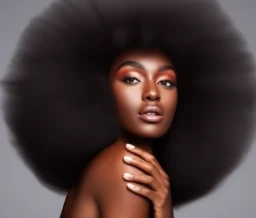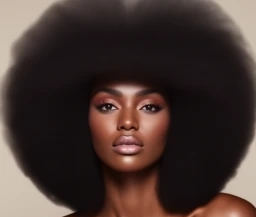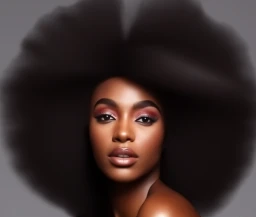Discover natural ingredients and a simple routine to moisturize, grow, and protect your 4C natural hair for healthy, strong strands.
Understanding 4C Hair
Type 4 hair is beautiful, versatile, and 4C has the tightest curl pattern in the hair typing system. It has a zigzag pattern and tends to shrink up to 75% of its actual length. It is delicate and prone to dryness and breakage if not properly maintained. Moisture is the key to managing and growing 4C hair.

The Key is “MOISTURE”

Moisture is essential for soft, manageable, and breakage-free 4C hair. Due to the tight curls, natural oils from the scalp struggle to travel down the hair shaft. This leaves 4C hair prone to dryness, especially the ends, which are the oldest part of the hair. Moisturizing your hair regularly prevents breakage and supports hair growth. Please note that regularity is relative and depends on your individual hair needs. Why do I say this? Because you have to experiment until you find the sweet spot for your hair-in reference to moisture, of course. Do not make the mistake of copying some else’s moisturizing routine blindly. Well, you might think their hair looks exactly like yours, but remember HAIR POROSITY matters. If their hair porosity is different from yours, their routine might not work. HAIR HEALTH is another factor; if you are just starting on your Natural hair care journey, copying a routine might not work for you, even if it works for them.
How to Moisturize Natural Afro-hair

First, we have identified that moisture is key, right? This is my recommendation: START BY MOISTURIZING DAILY. Get yourself a proper spritz bottle, cold water is fine, do not complicate things. Spritz your hair gently with water until it is damp. Follow up with a good leave-in conditioner (this step is optional, but if you can afford one, please do it; remember a little goes a long way, do not overload your hair with leave-in. Then seal the moisture in with an oil or hair butter of your choice (This also depends on your hair porosity, which I will address in the next post). So now your hair is moisturized, and moisture has been sealed with an oil or butter, but why did you forget to massage your scalp? Please remember to massage for at least 3-5 minutes; this last step is as important as the first step, so don’t skip it all the time.
Once you begin moisturizing daily, after a while, you may notice that you may be able to go a day or two without moisturizing, but your hair still feels soft and fluffy. This is when you can adjust to moisturizing 2-3 times a week, but if you can still do it more frequently, please do.
Extra Tips to Grow and Maintain Healthy 4C Hair
- Please drink plenty of water and eat a nutrient-rich diet; do not just focus on external nurturing of your hair.
- Avoid frequent heat styling or quit heat styling if you can.
- Please don’t detangle dry hair; moisturize it first.
- I recommend washing your hair bi-weekly or weekly, though this will largely depend on the hairstyle you are wearing and how frequently you moisturize. If tough comes to tough, wash your hair at least once a month.
- Skip styling your hair with synthetic hair extensions, or keep it gentle and minimal.
- Use a microfiber towel or a t-shirt to dry hair gently.
- Be consistent with your routine to see results.
- Be patient. Hair grows about half an inch per month on average.
Night Care for 4C Hair

Nighttime care helps keep moisture locked in, prevents damage from rubbing against bedding, and keeps your hair together, which is crucial. Do these to protect your hair before bed:
- Always use a satin or silk bonnet or pillowcase; do not compromise.
- Put hair in chunky twists or a loose style.
- Try to moisturize your hair before bed to seal in moisture.
Protective Styling for 4C Hair Growth
Protective styles reduce breakage and retain length. Consider these low-maintenance protective hairstyles:
- Natural Twists
- Buns (from twa puffs, mini buns to single buns)
- Natural Braids
- Natural Bantu knots
- Natural Cornrows
- You can also wear these styles under a wig if you need to.
- Simply leave your hair alone
Always moisturize and cleanse your scalp, even when in a protective style. Avoid styles that cause tension on the scalp or edges.
